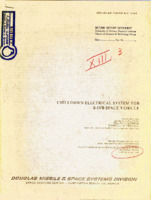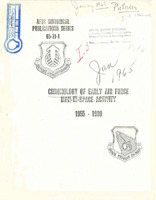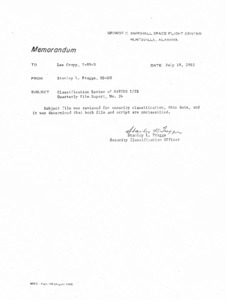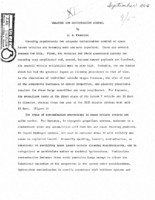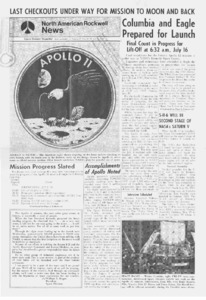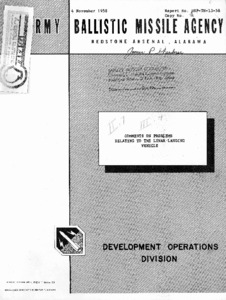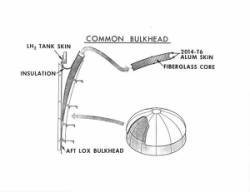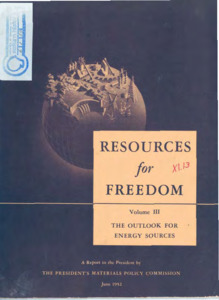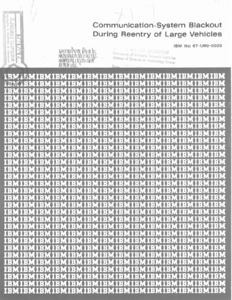
Browse Items (970 total)
Sort by:
-
"Chilldown Electrical System for S-IVB Space Vehicle."
The paper is marked, "To be presented at the IEEE 1965 Aerospace Conference featuring Flight Vehicle Electrical/Electronics Systems, Houston, Texas, June 20-24, 1965." The abstract states "This paper presents the electrical system used to drive the chilldown motor pumps on the S-IVB space vehicle. This system consists of a 56 volt battery supplying power to the two three-phase solid state inverters which in turn drive two cryogenic motor pumps. Included in this paper is a short description of the overall chilldown system requirements. The advantages of the a-c system over the d-c system are discussed with emphasis on weight and reliability. Two functionally identical 1.5kva inverters were designed. One inverter uses germanium transistors in the output stage while the other uses silicon transistors. Both inverters were designed to have a quasi-square wave output. The inverter circuitry is described and the advantages of each is discussed including a comparison of weight, size, operating temperature, efficiency and voltage rating." Includes diagrams. -
"Chronology of early Air Force man-in-space activity: 1955 - 1960."
The foreword states "In this chronology, Air Force manned space flight activity is viewed from the perspective of the ballistic missile development agency - the Air Research and Development Command's Western Development Division, later re-named the Air Force Ballistic Missile Division. Due to resource limitations at the Space Systems Division historical office, research for this chronology has been generally limited to materials available in the files of that office. All documents cite in the notes which follow each entry are located in the archives of the Historical Division, Office of Information, Space Systems Division, in Los Angeles California." There are handwritten notes throughout. -
"Classification review of Saturn I/IB quarterly film report, no. 24."
Memo to Lee Cropp, I-RM-D concerning security classification. -
"Cleaning and Contamination Control."
The document is a paper describing contamination cleaning methods and advocating for further developments in the field. Tables and figures are included at the end of the paper. The figures include a comparison of Saturn V with Saturn I and Saturn IB and cross-sections of the Saturn C-5, S-IC stage fuel tank assembly and oxidizer tank assembly. -
"Columbia and eagle prepared for launch."
A news article detailing the scheduled launch for the Apollo 11. "Eagle" is the name of the lunar module and "Columbia" is the name of the service module. -
"Comments on Problems Relating to the Lunar-Landing Vehicle."
"This technical note concerns some of the problems encountered with the landing of a payload on the moon. The main problem areas such as guidance, velocity control and impact considerations are discussed. Although no final conclusions or designs are intended, it is hoped that the material presented will serve as a guide for future detailed work." -
"Common bulkhead drawing."
8 x 10 inch black and white photograph; This is a cutaway drawing of the bulkhead with information about the LH2 tank skin, insulation, Aft LOX bulkhead, 2014-T6 alum skin and fiberglass core. Part of an envelope with photos accompanying C. E. Cataldo paper "Materials in Space Exploration." -
"Communication from the President of the United States transmitting the report of the President's Materials Policy Commission, June 1952."
Includes bibliographical references.; Original format: paperback book (42 pages); Cover title: Resources for freedom : the outlook of energy resources, volume III. Contains plans and analyses of potential future energy sources. -
"Communication-System Blackout During Reentry of Large Vehicles".
This paper was published in the Proceedings of the IEEE, volume 55, number 5, May 1967.; ABSTRACT: Much of the theoretical research on reentry blackout is in a format difficult for the communications design engineer to use in his system analysis. This paper derives simplified equations for the average sheath power loss that may be added (in dB) to the usual space loss to obtain an approximate total propagation loss. The plasma and sheath properties are discussed in detail but largely without supporting mathematics, in order to give the design engineer a better understanding of the overall problem. For the same reason and to provide insight into the final results, the average radiated power is found, using both intuitive and rigorous techniques. Several graphs of plasma properties are included in the development as an aid to numerical computation, and results are compared with the work of other authors. -
"Company announces scholarship winners: Space Division places 9 of 21 boys and 16 girls."
A news article detailing the winners of scholarships from a competition held by Space Division. This contest was held for the children of Space Division employees.
